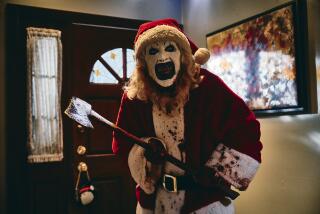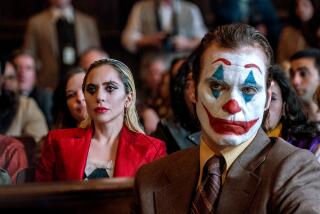Horror Upon Horror
When Hannibal Lecter informed FBI agent Clarice Starling he was going to have “an old friend for dinner” at the conclusion of “The Silence of the Lambs,” everyone knew it was inevitable that Dr. Lecter would return for another mouthwatering excursion into horror.
A decade after the release of the Oscar-winning “Silence of the Lambs,” the good doctor is back licking his chops in “Hannibal,” which opens Friday. Anthony Hopkins returns in his Oscar-winning role, with Julianne Moore taking over the role of Starling from Jodie Foster. The film is directed by Ridley Scott; Jonathan Demme won an Oscar for directing the original.
“Hannibal” is a co-production of MGM and Universal Studios. It seems apropos that Universal is involved in resurrecting one of cinema’s greatest horror characters. During the 1930s and ‘40s, Universal was the home of such classic horror creations as Frankenstein, Dracula, the Mummy and the Wolf Man. These fiends proved to be so popular with audiences, Universal kept bringing them back in various incarnations--and often paired with one another, two monsters for the price of one.
Horror sequels have a long--if not always distinguished--history at Universal. Here’s a look at the Universal creatures and the features they appeared in:
Frankenstein
“Frankenstein” (1931): James Whale directed this highly entertaining adaptation of Mary Shelley’s classic horror novel starring Colin Clive as the manic Dr. Frankenstein and a memorable Boris Karloff as his high-foreheaded, neck-bolted creation.
“The Bride of Frankenstein” (1935): Whale also directed this sequel, which is far superior to the original. This wickedly funny entry finds the monster (Karloff) learning how to talk and insisting he have a bride. Clive returns as Dr. Frankenstein and Elsa Lanchester plays the doctor’s latest creation.
“Son of Frankenstein” (1939): Karloff made his last appearance as the monster in this underrated chiller directed by Rowland V. Lee. Basil Rathbone stars as the doctor’s son who returns to his hometown to recover the family name by transforming the monster into something good. Bela Lugosi also stars as Ygor, a crazed man who had survived a hanging.
“Ghost of Frankenstein” (1942): The fourth entry in the series finds Ygor (Lugosi) resurrecting the monster (Lon Chaney Jr.) and bringing him to Frankenstein’s son (Cedric Hardwick). The son wants to put the brain of an educated man into the monster, but Ygor has other plans.
“Frankenstein Meets the Wolf Man” (1943): The continuation of “The Wolf Man” and “Frankenstein” finds the hairy Larry Talbot (Chaney Jr.), who was presumed dead, breaking out of his coffin to force Dr. Frankenstein (Patric Knowles) to end the curse on his life. For the first and only time during his career, Lugosi plays the Frankenstein monster.
“House of Frankenstein” (1944): Karloff returns to the “Frankenstein” fold, but this time around he plays a demented scientist. John Carradine takes over as Dracula and Glenn Strange makes his first appearance as the Frankenstein monster. J. Carrol Naish also stars.
“House of Dracula” (1945): Actually a part of the Frankenstein family. This sequel to “House of Frankenstein” finds a scientist (Onslow Stevens) trying to cure the ills of the Wolf Man (Chaney Jr.), Dracula (Carradine) and the Frankenstein monster (Strange).
“Abbott and Costello Meet Frankenstein” (1948): Hilarious horror comedy--a late-night television staple for years--finds Bud and Lou meeting up with the Frankenstein monster (Strange), the Wolf Man (Chaney Jr.) and Dracula (Lugosi--in his first appearance as the character since 1931).
Dracula
“Dracula” (1931): After making his mark on Broadway as the bloodthirsty count, Hungarian actor Bela Lugosi became an overnight movie sensation in this creaky but endearing adaptation of Bram Stoker’s novel directed by Tod Browning.
“Dracula’s Daughter” (1936): Gloria Holden plays the title role in this spooky chiller that also stars Otto Kruger.
“Son of Dracula” (1943): Robert Siodmak (“The Killers”) directed this effective chiller starring Lon Chaney Jr. as the son of Count Dracula who arrives in the Deep South to check out the bloodlines. Chaney Jr. is the only actor to have played all four of the Universal horror stars.
The Mummy
“The Mummy” (1932): Boris Karloff stars as the Egyptian mummy who is brought back to life after thousands of years in this creepy chiller directed by noted cinematographer Karl Freund.
“The Mummy’s Hand” (1940): Though not exactly a sequel to the 1932 “Mummy,” this low-budget flick does utilize footage from the original. Dick Foran and Wallace Ford play two bumbling archeologists who discover the tomb of an Egyptian princess guarded by a living mummy, Kharis (Tom Tyler).
“The Mummy’s Tomb” (1942): In this sequel to “The Mummy’s Hand,” Kharis (Lon Chaney Jr.) arrives in America to kill off the members of an expedition.
“The Mummy’s Ghost” (1944): Chaney Jr. returns in this third entry in the Kharis series. This time around, Kharis and his mentor (John Carradine) are on the prowl for a woman who resembles an ancient princess.
“The Mummy’s Curse” (1944): In the final installment in the Kharis series, the mummy (Chaney Jr.) is up to his evil ways in Louisiana. William Farnum, the famed silent-screen star, has a tiny part as a caretaker.
“Abbott & Costello Meet the Mummy” (1955): Grade-Z comedy finds the duo meeting up with the Mummy (Eddie Parker).
The Wolf Man
“The Werewolf of London” (1935): The very first werewolf movie stars veteran actor Henry Hull as a scientist who becomes a mad killer after he’s bitten by a werewolf.
“The Wolf Man” (1941): Heart-pounding horror flick starring Lon Chaney Jr. as mild-mannered Larry Talbot who, after he is bitten by a werewolf (Bela Lugosi), finds himself turning into a bloodthirsty wolf whenever there is a full moon. Claude Rains and Maria Ouspenskaya head the strong supporting cast. Penned by the great Curt Siodmak.
“She-Wolf of London” (1946): June Lockhart believes she’s really as hairy as Lassie in this anemic thriller in which young Lockhart is led to believe she is a werewolf.
More to Read
Only good movies
Get the Indie Focus newsletter, Mark Olsen's weekly guide to the world of cinema.
You may occasionally receive promotional content from the Los Angeles Times.











